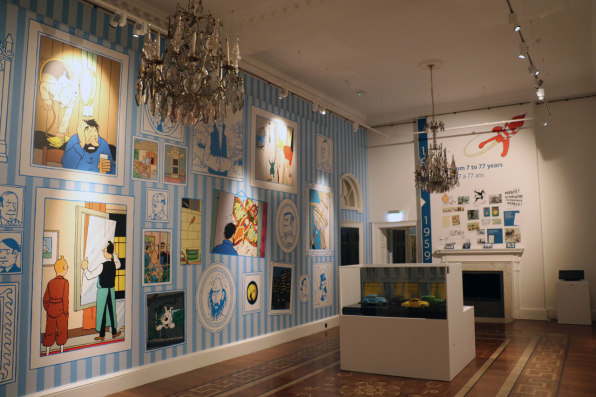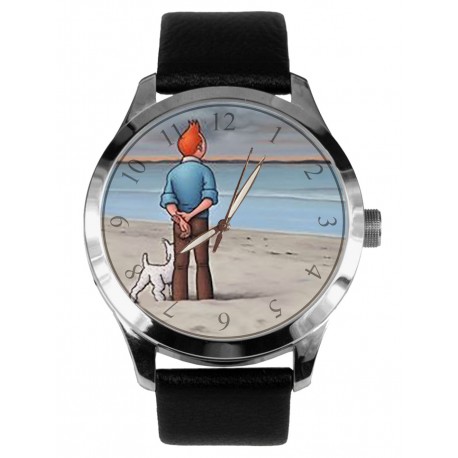No products
Comic Art Watches
New products
-

Seth vs Osiris, Ancient Egypt Metallic Original Art Solid Brass Collectible Mens' Watch
40 mm solid brass casing in gold finish with stainless steel back...
$ 121.44 -

Chinese Traditional Good Luck Dragon Art Gold Medallion Solid Brass Men's Watch
40 mm solid brass casing in gold finish with stainless steel back...
$ 129.59 -

English Colours Fire-Breathing Dragon Ancient Parchment Fantasy Art Brass Watch
40 mm solid brass casing in gold finish with stainless steel back...
$ 137.74 -

Ancient Blue Fire-Breathing Dragon Parchment Art Solid Brass Mens Dress Watch
40 mm solid brass casing in gold finish with stainless steel back...
$ 137.74 -

Golden Dragon Metallic Art Solid Brass Collectible Men's Fantasy Good Luck Watch
40 mm solid brass casing in gold finish with stainless steel back...
$ 121.44
Tintin by the Beach. Contemporary Comic Existentialist Art Collectible Solid Brass Wrist Watch
COM-09006C
New product
- Premium Citizen 2040 quartz movement.
- 40 mm large size heavy brass case.
- Rubberized Leather band.
- Unique Collectible Limited Edition Handmade Watches.
More info
Since its first appearance in a Belgian newspaper in 1929, The Adventures of Tintin–the beloved comic that follows the escapades of an intrepid boy reporter and his trusty dog Snowey–has been translated into more than 50 languages. Though considerably more popular in Europe than stateside, the comic was adapted in a 2011 Steven Spielberg film, and Tintin’s creator Hergé could once count Andy Warhol and Roy Lichtenstein among his many fans.
Hergé had his own influences as well (for Warhol and Lichtenstein, the appreciation was mutual), which ranged from the Constructivist work he studied during his childhood in Belgium to a later fascination with modernist graphic design and artists like Joan Miró. A new exhibition at Somerset House in London, Tintin: Hergé’s Masterpiece–along with a companion book of the same name out this month from Rizzoli–explore how both these interests and the events of World War II influenced the evolution of Hergé’s work.

Tintin first appeared in the Belgian Catholic newspaper Le Vingtième Siècle, where Hergé worked for the children’s supplement until the paper was closed down by the Nazis in 1940. He then went to work for the newspaper Le Soir, at the time was run by Nazis. His comics typically appeared alongside sports, stock market numbers, and cultural news, though sometimes they would also run beside reports of Germany’s victories. “It was not ideal,” Tintinologist Michael Farr, who help set up the show, tells the BBC., “but he was locked into [the job] and he thought it was for the good. He thought that Tintin was important for cheering Brussels up.”
In his early newspaper strips, Hergé’s drawings were simpler than in his more graphic work later on, but because of his love of architecture and design, the settings were always rendered in meticulous detail. “We have some facsimiles of early drawings alongside original cover pages of journals and magazines that the cartoon first appeared in, and you really get a sense of how good of a draftsman Hergé was,” says Stephen Doherty, director of visitor communications at Somerset House. “You could view his drawings as mini masterpieces in their own right–with just a couple of strokes, for example, he could give an impression of a slippery floor.”

Doherty credits Hergé’s penchant for architecture and design as one of the reasons windows play such a big role in the comics. Hergé uses windows as a plot device–Tintin first meets his companion Captain Haddock through a porthole, for example–and also as a way to highlight the news of the day as Tintin peered out into the world. “These stories weren’t just for children, they were very much meant for adults as well,” Doherty says. “Tintin landed on the moon when no one else did, and that was very much a reflection of the Space Race. It was drawn from the context of the time.”
After the war, Tintin became more popular than ever when Hergé penned the 23 now canonical graphic novels chronicling his adventures. This was also the period that solidified Hergé’s genre-defining graphic style of clean lines and bold colors used by many graphic novelists since. “He had a great fascination for film and was a patron for art in general,” Doherty says. Besides his pop-artist contemporaries like Warhol and Lichtenstein, Hergé’s “clear line” style was also influenced by eastern art, like the wood-block prints of Utagawa Hiroshige and other Japanese “ukiyo-e” artists.
Reviews
No customer reviews for the moment.





